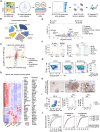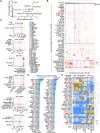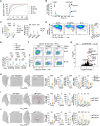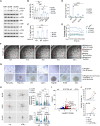Ligand-receptor interactions induce and mediate regulatory functions of BATF3+ B cells
- PMID: 41061049
- PMCID: PMC12506935
- DOI: 10.1126/sciadv.adx9917
Ligand-receptor interactions induce and mediate regulatory functions of BATF3+ B cells
Abstract
B cells express many protein ligands, yet their regulatory functions are incompletely understood. We profiled ligand expression across murine B sublineage cells, including those activated by defined receptor signals, and assessed their regulatory capacities and specificities through in silico analysis of ligand-receptor interactions. Consequently, we identified a B cell subset that expressed cytokine interleukin-27 (IL-27) and chemokine CXCL10. Through the IL-27-IL-27 receptor interaction, these IL-27/CXCL10-producing B cells targeted CD40-activated B cells in vitro and, upon induction by immunization and viral infection, optimized antibody responses and antiviral immunity in vivo. Also present in breast cancer tumors and retained there through CXCL10-CXCR3 interaction-mediated self-targeting, these cells promoted B cell PD-L1 expression and immune evasion. Mechanistically, Il27 and Cxcl10 transcription was induced by synergizing Toll-like receptor (TLR) and CD40 signals and driven by coinduced transcription factor BATF3, which directly targeted these genes. By applying a discovery framework focusing on regulatory cells, our findings expand the recognized scope of B cell regulatory functions.
Figures








References
-
- Victora G. D., Nussenzweig M. C., Germinal centers. Annu. Rev. Immunol. 40, 413–442 (2022). - PubMed
-
- Shen P., Fillatreau S., Antibody-independent functions of B cells: A focus on cytokines. Nat. Rev. Immunol. 15, 441–451 (2015). - PubMed
-
- Rosser E. C., Mauri C., The emerging field of regulatory B cell immunometabolism. Cell Metab. 33, 1088–1097 (2021). - PubMed
MeSH terms
Substances
LinkOut - more resources
Full Text Sources
Research Materials

